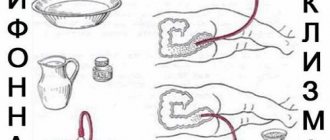Home » Rectocele (protrusion of the rectal wall)
Rectocele of the rectum is considered a rare and not common disease. According to medical statistics, pathology is most often diagnosed in women after menopause. Rectocele or prolapse also develops in men, but much less frequently. Often, patients do not pay attention to the appearance of symptoms, as they confuse them with gastrointestinal disorders and self-medicate. Incorrect treatment and lack of diagnosis lead to complications.
Contact the doctors at the medical proctology clinic “Proctologist 81”. Qualified specialists will conduct a preventive examination, refer you to diagnostic tests and prescribe effective treatment.
Reasons for development
In 80% the disease is asymptomatic. Patients do not pay attention to the pain that appears from time to time. In the early stages, there are no symptoms at all. There are a number of reasons that could influence the development of pathology. The main factor that contributes to the appearance of an anterior rectocele is a weakened rectovaginal septum and pelvic floor muscles.
There are other reasons, including:
- weak muscles of the pelvic floor, rectovaginal septum, which are thinned in utero;
- ruptures or incisions of the perineum during labor, childbirth of a large fetus;
- chronically increased intra-abdominal pressure due to impaired functioning of the gastrointestinal tract or excessive physical exertion;
- functional disorders of the anal sphincters;
- age-related dystrophic changes in the sphincters, pelvic floor muscles and rectovaginal septum;
- acute and chronic forms of genital diseases in women;
- consequences of hysterectomy or removal of the uterus.
In young girls, rectocele is diagnosed after childbirth, after an abortion or miscarriage. The development is also caused by congenital weakness of the rectovaginal septum and pelvic muscles.
In women after menopause, rectocele develops after numerous births, age-related changes, and intestinal problems.
Complications of rectocele
If prolapse is not detected in time and treatment is not started, the patient runs the risk of complications. These include:
- prolapse of the uterus and genital organs;
- urinary and/or fecal incontinence;
- formation of rectal fistulas;
- damage to the intestinal walls followed by bleeding, which in most cases will be hidden, causing iron deficiency anemia;
- severe pain in the perineum during sexual intercourse.
Eliminating these problems is much more difficult than prolapse. Therefore, it is better to start complex therapy immediately after diagnosis and follow all doctor’s recommendations.
Rectocele symptoms
The symptoms of rectocele depend on the stage and severity of the pathology. Proctologists distinguish several stages during which the functionality of the rectum changes.
| First degree rectocele | In most cases, at the first stage there are no symptoms, the patient is unaware of the development of the disease. Sometimes defecation is disrupted, constipation and diarrhea appear. The feces enter the protrusion and remain in this area, even if the patient strains during bowel movements. As treatment, the patient is prescribed laxatives, enemas, or treatment with folk remedies. Drug therapy will help get rid of pain, and not eliminate the source of the disease. |
| Second degree rectocele | At this stage, the patient feels incomplete bowel movement and a sensation of a foreign body in the anus. Large amounts of feces are retained in the body, causing the rectum to protrude. To completely empty the rectum, the patient is forced to go through bowel movements several times. In some cases, you will need to press on your stomach or take laxatives. From time to time the patient is bothered by pain in the intestines and cramps. Inflammatory and infectious processes develop in the body, as feces stagnate in the distal parts of the rectum. The patient tries to push the stool with his hands through the back wall of the vagina. Concomitant diseases also develop. Among them are hemorrhoids, proctitis, the appearance of anal fissures and scars. It is mandatory to take laxatives. |
| Third degree rectocele | At the third stage, all of the above symptoms are observed, but they bother the patient much more often. Every day, part of the rectum falls out and moves into the vagina and genital opening. The patient suffers from the sensation of a foreign body in the anus and genital tract. False urges to defecate appear, but the process of defecation itself is absent. A genital tract infection occurs and the uterus prolapses. There are problems with urination. Laxatives do not make bowel movements easier, so the patient helps the bowel movement by applying pressure to the affected area. |
Without treatment and diagnosis, the disease rapidly develops and progresses. To avoid complications, pay attention to complaints and symptoms. Symptoms of rectocele in men are similar. Pain appears during bowel movements, appetite worsens, the patient becomes angry and irritable.
Diagnostics
Diagnosis of rectocele consists of collecting the patient’s complaints, ascertaining the history of the disease and life. This allows us to determine the causes of the disease and suggest existing anatomical defects of the pelvic floor. Next, a standard gynecological examination is performed, which gives an idea of the degree of prolapse and the condition of the perineum. There are four degrees of rectocele:
- 1st degree – when there is a slight prolapse, which is determined only during a gynecological examination and does not reach the entrance to the vagina by more than 1 cm;
- 2nd degree - when the prolapse of the posterior wall does not reach the entrance to the vagina a little or falls below it, but not more than 1 cm;
- 3rd degree - in this case, the rectocele descends more than 1 cm from the entrance to the vagina, but no more than 5-7 cm;
- 4th degree – complete inversion of the posterior vaginal wall.
To clarify what exactly comes out along with the back wall of the vagina, a gynecological examination is always supplemented by a digital rectal examination - examination of the rectum with a finger through the anus.
Diagnosis of the disease
The patient attends a consultation with a gynecologist. A medical specialist analyzes the patient’s medical history, symptoms, complaints, frequency and intensity of pain. After this, the gynecologist examines the woman in a gynecological chair. The expected diagnosis and stage of the disease and associated pathologies are determined. The patient is pushing. During this, the doctor observes the cystorectocele protruding from the back of the vagina. The gynecologist palpates the vagina and anus. The size of the tumor and the degree of pathological changes are determined.
To establish an accurate diagnosis, diagnostic studies are carried out, including:
- anoscopy;
- sigmoidoscopy;
- functional study of the anal sphincters (sphincterometry and electromyography);
- proctography with straining.
After instrumental examinations, the attending physician determines the exact size of the protrusion, the mechanism of defecation disturbance, and the presence of concomitant pathologies. If there is a suspicion of hidden intestinal bleeding, a stool test is performed for occult blood.
The patient’s blood is also examined to determine the inflammatory process in the body, anemia and diseases of the internal organs. Laboratory diagnosis is required before surgery and removal of rectal prolapse.
It is extremely important to conduct diagnostic studies, since the external diagnosis of rectocele is similar to cystocele and hernia of the rectovaginal septum. The dynamics of recovery depend on the correctness of the chosen treatment. Women who are pregnant should be especially careful. Rectocele during pregnancy can negatively affect the condition of the fetus.
Leading specialists in the treatment of vaginal rectocele in the North Caucasus
Ermolaeva Elvira Kadirovna A well-known and recognized specialist in the North Caucasus in the treatment of rectocele, uterine prolapse WITHOUT SURGERY, vaginal reduction with vaginal threads and treatment of urinary incontinence. Women who are exhausted by vaginal prolapse and who want to improve the aesthetics of the genital organs and refresh intimate relationships come to her from women from all regions of Russia and foreign countries.
Ermolaev Oleg Yuryevich Candidate of Medical Sciences, operating gynecologist with 25 years of successful experience in treating rectocele, uterine prolapse and vaginal wall prolapse, uterine prolapse in old age. Able to see relationships that elude others.
About the doctors of the Clinic in detail...
| The company "Resort Clinic for Women's Health" LLC was among the NOMINANTS and has the right to receive the STATUS "Best Enterprise in Russia 2019". The analysis was carried out based on data from the State Statistics Service, according to OKVED 86.21 “General Medical Practice”. According to the indicators of the last reporting period, Women's Health Resort Clinic LLC was classified as a reliable enterprise and, based on the rating, took “1” (first) place among all companies in the region (North Caucasus Federal District). |
We accept girls and women from all cities of Russia, near and far abroad, and assist in accommodation. About accommodation in detail...
Treatment program cost
| Diagnostics | price | quantity | 7 days | ||
| Primary consultation with a gynecologist | 2300 | 1 | 2300 | ||
| Repeated consultation with a gynecologist | 1250 | 1 | 1250 | ||
| Pelvic ultrasound | 1550 | 1 | 1550 | ||
| Extended colposcopy | 1650 | 1 | 1650 | ||
| Microscopic examination of the flora of smears from the vagina and cervix | 350 | 1 | 350 | ||
| Cytological examination of scrapings of the cervix and cervical canal | 500 | 1 | 500 | ||
| MAXIMUM COST OF DIAGNOSTICS | 7600 | ||||
| Treatment | price | quantity | 7 days | ||
| Hardware vaginal gymnastics | 600 | 7 | 4200 | ||
| Magnetic laser stimulation of the perineal muscles | 750 | 7 | 5250 | ||
| Vaginal vibration massage | 450 | 7 | 3150 | ||
| Uterine repositioning | 650 | 7 | 4550 | ||
| MAXIMUM COST OF TREATMENT | 17150 | ||||
| The treatment program is adjusted taking into account individual characteristics and previous treatment. | |||||
| Full cost of the treatment program | 24750 | ||||
| The cost of the program may change (downward) if a previously conducted examination is available. | |||||
| When paying for the treatment program as a one-time payment, the final cost of treatment is 15% less than when paying for each procedure separately. | |||||
Expand table ⇓
Our specialized gynecological clinic operates on paid services and in the voluntary health insurance system.
We work WITHOUT WEEKENDS and holidays:
Monday - Friday from 8.00 to 20.00, Saturday, Sunday, holidays from 8.00 to 17.00.
Treatment in Pyatigorsk by appointment via multi-channel telephone number 8 (calls within Russia are free), or.
The cost of treatment for vaginal rectocele is 17,150 rubles.
The cost of vaginal reduction with vaginal threads is 55,000 rubles.
| You can talk to a gynecologist ONLINE about the treatment method here. REGISTER ONLINE for treatment here. REGISTER online for treatment |
Sign up
With respect for the religion and different habits of our Patients, we achieve high efficiency and comfort of treatment.
WE HELP even in the MOST difficult cases.
We are at your FULL DISPOSAL if you have any doubts or wishes.
- About the Clinic
- Clinic team
- Rectocele REVIEWS
- REDUCTION OF THE VAGINA WITH VAGINAL THREADS
- How to prepare for an appointment with a gynecologist?
Subsections
- Program No. 1. Treatment of inflammatory and infectious processes of the pelvis
- Program No. 2. Treatment of urinary incontinence, treatment of uterine and vaginal prolapse
- Program No. 3. Treatment of female infertility
- Program No. 4. Cervical treatment
- Program No. 5. Treatment of uterine fibroids
- Program No. 6. Treatment of cervicitis and endocervicitis
- Program No. 7. Recovery after childbirth and narrowing of the vagina
- Program No. 8. Treatment of chronic cystitis
- Program No. 9. Treatment of menopause
- Program No. 10. Treatment of mastopathy
- Program No. 11. Treatment of endometriosis
- Program No. 12. Treatment of hydrosalpinx
- Program No. 14. Treatment of polycystic ovary syndrome
- Program No. 15. Preparation for IVF, ICSI, artificial insemination
- Program No. 16. How to remove belly fat
- Program No. 17. Treatment of kraurosis
- Program No. 18. Treatment of vulvar leukoplakia
- Program No. 19. Prevention of mastopathy
- Appointment with a gynecologist to “check for EVERYTHING”
Treatment methods
If the patient has a prolapsed rectum, then complex treatment is carried out, which includes drug therapy and minimally invasive methods. Doctors normalize intestinal microflora and peristalsis, restore the condition and function of the rectum. Treatment in the early stages will help stop the progression of the disease.
In order to permanently get rid of a rectocele, surgery is performed to restore the position of the rectum. Before the procedure, the patient is treated with conservative methods to correct the motor and evacuation functions of the distal colon. You should follow a diet, monitor your daily routine and diet, take medications only after consulting a doctor, and perform special physical exercises.
Diagnosis of rectocele
In most cases, a rectocele can be detected during a routine examination of the vagina and rectum. More accurate data is obtained using an x-ray research method - defecography, which allows you to establish an accurate diagnosis and choose the optimal method of treatment.
Treatment of rectocele
Treatment begins with conservative correction of disorders of the motor-evacuation function of the colon. A conservative therapy regimen is used in the pre- and postoperative periods. In particular, it includes: a diet high in fiber and water. In the initial stage, it is useful to carry out a complex of physical therapy. This complex is primarily aimed at strengthening the pelvic floor muscles and eliminating constipation. It is possible to avoid surgery if you follow these recommendations. Avoid prolonged straining during bowel movements. Sometimes it can be helpful to apply pressure on the rectocele with your finger, this will change the direction of the stool. This can be done by pressing on the back wall and along the edge of the vagina. You should not insert your finger into the rectum to remove stool, as this may damage the intestine.
Surgery for rectocele
There are several ways to treat rectocele. Surgical treatment of rectocele can be carried out through approaches through the rectum, vagina, perineum, and through the abdominal cavity. In cases of severe prolapse of the pelvic organs, the surgical approach can be combined. Thanks to the capabilities of a multidisciplinary hospital, we have the opportunity to invite gynecologists if only vaginal symptoms are of concern.
Rehabilitation after surgery On the day of surgery to treat rectocele, moderate dietary restrictions or abstinence from food and water are recommended, depending on the type of anesthesia used. The next day, during dressing, the tampon is removed from the vagina, and the vagina is irrigated with antiseptic solutions. The next day you are allowed to walk; there are no dietary restrictions. Starting from the next day after the operation, there are no restrictions on the diet, with the exception of hot and spicy dishes and alcohol. The first stool usually appears on the 3rd day. To alleviate it, it is possible to use mild laxatives. Life after surgery: recommendations At home after surgery for rectocele, it is recommended to douche with chamomile infusion 2-3 times a day. Individual recommendations are provided by the attending physician upon discharge from the hospital. You can shower immediately after discharge from the hospital. You should refrain from visiting the pool, sauna, and taking baths for the next 2-3 weeks after surgery, and not before the sutures on the vaginal mucosa have completely healed. Lifting weights of more than 1.5-2 kg is also permitted 2-3 weeks after surgery. It is advisable to abstain from sexual activity for a month after surgery.
Surgery
Surgical treatment is used for the second and third degrees of prolapse. If there is a tendency for the pathology to progress at the first stage, then the operation is performed as an emergency. Today, medicine uses several dozen surgical and minimally invasive techniques that are used for rectocele. Procedures are performed to strengthen the rectovaginal septum and eliminate rectal protrusion.
To eliminate rectotskele, the following methods are used:
- suturing the rectal wall;
- suturing the muscles that hold the rectum and the posterior wall of the vagina;
- installation of a mesh implant that holds the rectum in the correct position.
If diagnostic tests reveal concomitant diseases in the patient, then a combined operation is performed to correct the existing problems. These include hemorrhoids, inflammation of hemorrhoids, the appearance of rectal polyps, cystoceles, the formation of anal fissures and scars. Surgery to eliminate rectocele is performed using general or epidural anesthesia. Before the operation, the patient is consulted by an anesthesiologist.
The prognosis after the operation is positive. In most cases, there is no relapse and complications do not appear after surgery. Proctologists advise installing a mesh implant, which will reduce the risk of recurrence of the disease to zero. The rehabilitation period is thirty days. It is advised to refrain from sexual activity and physical activity. The patient adheres to a strict diet and monitors the digestion process.
Why does rectocele develop?
The content of the article
A common cause of rectocele development is age-related weakening of the muscles and ligaments of the rectal walls. In older women, this process is associated with natural hormonal changes - a decrease in the level of sex hormones (estrogens) in the blood. In some women, decreased pelvic muscle tone is hereditary, which leads to the development of rectocele at a young age.
The second most common cause of intestinal wall defects is repeated complicated childbirth, which causes overstretching of the pelvic muscles as a result of severe straining. The same consequences are observed in patients who suffer from constant constipation.
In young nulliparous women, rectocele can be a consequence of severe diseases of the respiratory system, which are accompanied by a severe cough. The risk of protrusion of the walls of the rectum towards the vagina also increases in patients with severe forms of obesity and in those women whose professions involve constant physical activity.
Diet and medications for rectocele
Conservative treatment for rectocele includes following a strict diet and taking medications. This treatment is used in the early stages of pathology, before surgery and during the rehabilitation period. Therapy affects the elimination of digestive problems, normalization of stool and the restoration of motor-evacuatory functions of the rectum.
In the second and third stages, treatment with conservative methods and diet is not effective. It affects the normalization of the gastrointestinal tract and the elimination of symptoms. The therapeutic diet includes eating foods that are rich in fiber and vegetable fats. The process of bowel movements improves, the stool becomes soft. The diet should include dairy products, fruits and vegetables, broths, and plenty of fluids.
The minimum amount of fiber that a person should consume daily is thirty grams. It is recommended to include cuts in the diet, which are added to soups, casseroles, porridges and other side dishes.
After consulting the attending physician, the patient begins to take medications. The conservative treatment period is 45 days, depending on the severity of the pathology. You should take medications before surgery to prepare your body.
Treatment will be effective and safe only if the course is prescribed by an experienced doctor. Self-medication leads to negative consequences. To avoid genital prolapse, conservative therapy is supplemented by wearing a pessary.
Operation
Video lecture for patients and colleagues. Prolapse of the uterus, bladder, rectum: symptoms, diagnosis, treatment, surgery. urologist, MD Shkarupa Dmitry Dmitrievich
The main treatment method for rectocele is surgery. Moreover, both gynecologists and proctologists (transanal reconstruction) deal with this pathology. However, according to international standards, the vaginal route is preferable, as it is more effective and safe. Surgery for rectocele consists of repairing the fascial defect (colporrhaphy) between the rectum and vagina, as well as reconstructing damaged structures of the perineum.
It has been proven that the use of synthetic prostheses in this case does not improve results, but significantly increases the risk of complications.
During the operation, it is very important to correctly reassemble the damaged fascia and perineum and excise old scars; otherwise, pain may occur, including during sexual intercourse, as well as problems with defecation. Moreover, the cosmetic effect will also largely depend on the experience of the surgeon.
Prevention
With congenital weakness of the pelvic muscles and rectovaginal septum, rectocele and prolapse are observed in most cases. To prevent the development of the disease and avoid complications, preventive measures should be followed.
Pay attention to the recommendations of proctologists:
- avoid gastrointestinal disorders, go to the toilet when the urge appears, do not strain when defecating;
- watch your weight - rapid obesity or weight loss contributes to the appearance of prolapse;
- watch your diet and eat foods high in fiber;
- do not self-medicate and diagnose inflammatory and infectious diseases of the gastrointestinal tract in a timely manner;
- avoid lifting heavy objects;
- strengthen the muscles of the pelvic floor and perineum.
Women should visit a gynecologist every six months, even if there are no complaints. During pregnancy, after abortion and after childbirth, it is recommended to attend a preventive examination more often.
How is Rectocele diagnosed?
To make a diagnosis of rectocele, a vaginal examination is required. It is performed in a horizontal position on a gynecological chair. During the examination, to adequately assess the degree of prolapse, the doctor will ask you to strain or cough. Additionally, to clarify the degree of damage to the pelvic floor muscles and the tendon center of the perineum, the doctor conducts a vaginal and rectal digital examination. To clarify the degree of dysfunction of the rectum Additional studies:
- Ultrasound of the pelvic organs;
- Ultrasound of the pelvic floor muscles to exclude failure of the pelvic floor muscles and the tendon center of the perineum;
- Filling out special questionnaires to structure the patient’s complaints and clarify the degree of dysfunction of the rectum.
Based on the examination results, a clinical diagnosis is made.
Back to contents
Causes of rectocele
Two factors lead to the formation of a rectocele:
- increased intra-abdominal pressure (may occur with frequent lifting of heavy objects, with a strong lingering cough);
- disturbances in the structure of the muscular-ligamentous apparatus (may be associated with prolonged constipation).
Among the most common causes of rectocele are:
- A disorder of the structure of the pelvic muscular system that developed during the prenatal period.
- Bowel changes seen in older people (muscles in the perineal area become weaker).
- Frequent constipation.
- Having excess weight.
- Diseases of the upper respiratory tract accompanied by cough (pneumonia, bronchitis, influenza).
- Difficult working conditions.
- Frequent pregnancies and childbirths.
1.General information
Rectocele (literally “rectal pouch”, synonym “rectal prolapse”) is a pathological condition in which the rectum bulges, protrudes through the muscular-ligamentous septum towards the tailbone or genitals, forming a diverticulum (hernia). Rectocele is often described as an exclusively female disease; Indeed, the anatomy of the pelvic organs in the two sexes differs in such a way that in the vast majority of cases, rectocele is diagnosed in women, mostly of mature age (those who have given birth and/or have reached menopause). This pathology, however, also occurs in men, almost always in the form of a posterior, coccygeal rectocele (unlike women, in whom the posterior and anterior variants are almost equally likely).
Medical and statistical data on the prevalence of rectal prolapse, gender dependence and other epidemiological features are strangely contradictory, or even directly opposite. In some sources, the disease is defined as rare, in other publications, proctologists speak of it as constantly occurring in clinical practice; You can even find reports that “rectal prolapse” is more common in men. Perhaps there are discrepancies in diagnostic approaches, but the most likely explanation seems to be that not in all cases a patient with a rectocele seeks medical help. Thus, according to some estimates, more than two-thirds of women suffering from rectocele prefer to endure it and “not advertise it,” or even do not consider it a disease at all, at least not a curable one. It should be noted that this position is not only deeply erroneous, but also dangerous, since rectocele tends to progress and can not only sharply reduce the quality of life, but also cause more than serious complications.
A must read! Help with treatment and hospitalization!











